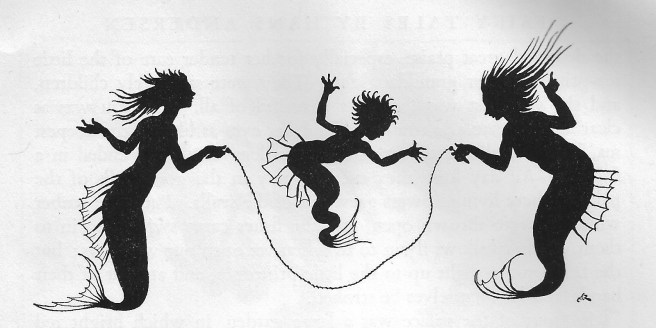 If you hear “The Little Mermaid” mentioned, it probably calls to mind either the disappointing statue in Copenhagen harbor, or, for anyone with kids under about twenty, the colorful, and equally disappointing, movie by Disney. Behind both is a powerful and beautifully tragic fairy tale by Hans Christian Andersen. As with many Andersen tales, it has much to enchant a child, but at the same time, it presents difficult themes and ideas that can engage an adult.
If you hear “The Little Mermaid” mentioned, it probably calls to mind either the disappointing statue in Copenhagen harbor, or, for anyone with kids under about twenty, the colorful, and equally disappointing, movie by Disney. Behind both is a powerful and beautifully tragic fairy tale by Hans Christian Andersen. As with many Andersen tales, it has much to enchant a child, but at the same time, it presents difficult themes and ideas that can engage an adult.
 Briefly, the little mermaid falls in love with a handsome young, human prince. In the hope of marrying him, she goes to the sea-witch, asking to have her fishtail transformed into human legs. The witch will oblige, but there is a price. The little mermaid must pay her loveliest attribute, her voice, in return, and every time she takes a step with her human legs, it will feel like she is walking on broken glass. If she succeeds in marrying the prince, she will gain not only her true love, but also a human soul and thereby life eternal. If she fails, she will die and disintegrate into sea-foam the day he marries another.
Briefly, the little mermaid falls in love with a handsome young, human prince. In the hope of marrying him, she goes to the sea-witch, asking to have her fishtail transformed into human legs. The witch will oblige, but there is a price. The little mermaid must pay her loveliest attribute, her voice, in return, and every time she takes a step with her human legs, it will feel like she is walking on broken glass. If she succeeds in marrying the prince, she will gain not only her true love, but also a human soul and thereby life eternal. If she fails, she will die and disintegrate into sea-foam the day he marries another.
As October rolls along, with its endless pink ribbons and pep rallies for breast cancer awareness, Andersen’s old tale comes to mind as an apt metaphor for what it is like to live with breast cancer. If you go to one of the pep rallies, also known as “Race for the Cure” events put on by Komen, you may be left with the impression that breast cancer is an illness akin to a bad case of the flu. Go to the doctor, do a bit of treatment, maintain a super-duper attitude and voila! you are a “Survivor.” Good as new, bye-bye cancer.
 In reality, survivorship for most breast cancer patients involves having relinquished attributes, i.e. breasts, in whole or in part, and taking a pill every day for five, ten or more years that causes chronic foot pain, among other unpleasant side effects. It also involves ongoing vigilance, scans, tests and visits to the oncology department. Many people are under the misapprehension that if you survive five years after a cancer diagnosis, you are in the clear. This is true for certain cancers, like leukemia and ovarian cancer. It is not true for most types of breast cancer. Breast cancer can recur as metastasis (meaning terminal disease) at any time and does in an estimated 25-30% of cases. There have been great advances in breast cancer treatment over recent decades, but those have mainly contributed to extending lifespans. The death rate for the disease remains high and fairly constant.
In reality, survivorship for most breast cancer patients involves having relinquished attributes, i.e. breasts, in whole or in part, and taking a pill every day for five, ten or more years that causes chronic foot pain, among other unpleasant side effects. It also involves ongoing vigilance, scans, tests and visits to the oncology department. Many people are under the misapprehension that if you survive five years after a cancer diagnosis, you are in the clear. This is true for certain cancers, like leukemia and ovarian cancer. It is not true for most types of breast cancer. Breast cancer can recur as metastasis (meaning terminal disease) at any time and does in an estimated 25-30% of cases. There have been great advances in breast cancer treatment over recent decades, but those have mainly contributed to extending lifespans. The death rate for the disease remains high and fairly constant.
 Plastic surgeons will replace the lost attributes, if the patient is willing to endure much pain and many surgeries. The replacements, however, will have no sensation and thus no sexual or other function. Replacements can be made from the patient’s own tissue, which involves cutting off either the stomach or the upper buttocks and moving the lumps of flesh to the chest. In some cases, the latissimus dorsi muscle is moved from back to front and backed with an implant. The descriptions of this surgery, also known as a “lat-flap,” do mention that it may result in decreased upper body strength and impaired mobility. But hey, at least you will have perky new tits!
Plastic surgeons will replace the lost attributes, if the patient is willing to endure much pain and many surgeries. The replacements, however, will have no sensation and thus no sexual or other function. Replacements can be made from the patient’s own tissue, which involves cutting off either the stomach or the upper buttocks and moving the lumps of flesh to the chest. In some cases, the latissimus dorsi muscle is moved from back to front and backed with an implant. The descriptions of this surgery, also known as a “lat-flap,” do mention that it may result in decreased upper body strength and impaired mobility. But hey, at least you will have perky new tits!
The little mermaid hoped for eternal life and was willing to pay a heavy price for it as well as risk gambling her life away all together. Likewise, the breast cancer patient pays the toll of treatment in the hope of living, knowing full well that the treatment itself could kill her (or him, as breast cancer affects men as well, although rarely).
 As you may have guessed or already know, the little mermaid dies at the end of the story because her prince marries someone else. However, she is given a last chance at life. The mermaid’s sisters have obtained a special knife from the sea-witch, paying for it with their beautiful hair. If the little mermaid kills the prince with this knife, and bathes her legs in his blood, they will grow back into a fishtail and she may return to the ocean and live out her full lifespan as a mermaid. Out of love, she refrains and is given a classic Andersen reprieve in death. Were she merely a mermaid, she would turn into foam and that would be that. Had she married the prince, she would have a soul and go to heaven. In Andersen’s compromise, she becomes a probationary angel, because she refrained from murder to save herself, and after 300 years of probation, she will get her eternal soul after all. Living with breast cancer is much like being on probation. It certainly beats being turned into sea-foam, but I refuse to participate in the Komen run, because since I am a breast cancer patient, who is thankfully still alive, they would give me a T-shirt proclaiming me a “Survivor.” If they gave me a shirt that said “On Probation”, I might reconsider.
As you may have guessed or already know, the little mermaid dies at the end of the story because her prince marries someone else. However, she is given a last chance at life. The mermaid’s sisters have obtained a special knife from the sea-witch, paying for it with their beautiful hair. If the little mermaid kills the prince with this knife, and bathes her legs in his blood, they will grow back into a fishtail and she may return to the ocean and live out her full lifespan as a mermaid. Out of love, she refrains and is given a classic Andersen reprieve in death. Were she merely a mermaid, she would turn into foam and that would be that. Had she married the prince, she would have a soul and go to heaven. In Andersen’s compromise, she becomes a probationary angel, because she refrained from murder to save herself, and after 300 years of probation, she will get her eternal soul after all. Living with breast cancer is much like being on probation. It certainly beats being turned into sea-foam, but I refuse to participate in the Komen run, because since I am a breast cancer patient, who is thankfully still alive, they would give me a T-shirt proclaiming me a “Survivor.” If they gave me a shirt that said “On Probation”, I might reconsider.

Illustrations by Arthur Rackham, from Fairy-Tales by Hans Andersen, David McKay Company, Philadelphia: 1932. Photograph by Beth Whaanga, who shows the reality of “surviving” breast cancer.


